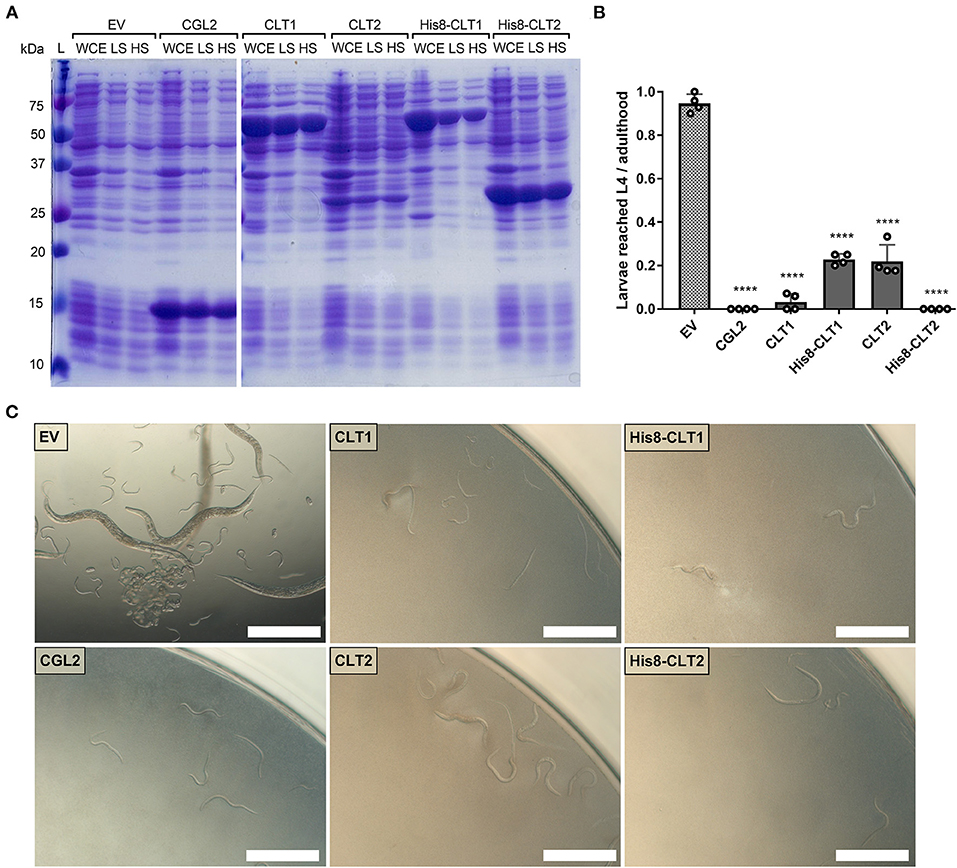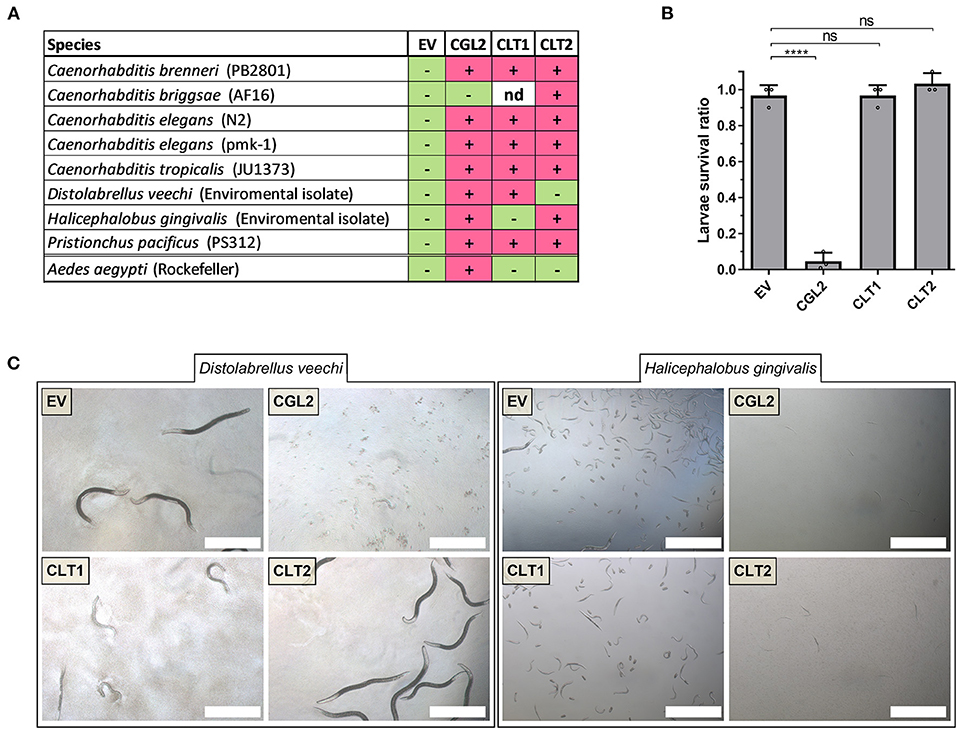
95% of researchers rate our articles as excellent or good
Learn more about the work of our research integrity team to safeguard the quality of each article we publish.
Find out more
ERRATUM article
Front. Fungal Biol. , 28 April 2022
Sec. Fungi-Animal Interactions
Volume 3 - 2022 | https://doi.org/10.3389/ffunb.2022.910647
This article is an erratum on:
Cytoplasmic Lipases—A Novel Class of Fungal Defense Proteins Against Nematodes
An Erratum on
Cytoplasmic Lipases—A Novel Class of Fungal Defense Proteins Against Nematodes
by Tayyrov, A., Wei, C., Fetz, C., Goryachkin, A., Schächle, P., Nyström, L., and Künzler, M. (2021). Front. Fungal Biol. 2:696972. doi: 10.3389/ffunb.2021.696972
Due to a production error, in the original article, incorrect files were used for Figure 3 and Figure 5. The corrected Figure 3 and Figure 5 appear below.

Figure 3. CLT1 and CLT2 are nematotoxic proteins with predicted lipase domains. (A) Coomassie-stained SDS-PAGE showing heterologous expression and solubility of wild-type and His8-tagged CLT1 and CLT2 proteins. Twenty microliters of whole-cell extract (WCE) and supernatants of low-spin (LS; 5min. at 5,000 g) and high-spin (HS; 30 min. at 16,000 g) bacterial lysate were loaded on a gel. CGL2 was used as a positive control and an “empty” vector (EV) was used as a background control for IPTG-induced expression and solubility. (B) Toxicity of untagged CLT1 and CLT2 as well as of their His8-tagged versions against C. elegans N2. IPTG-induced E. coli BL21 expressing previously characterized nematotoxic protein CGL2 and containing an “empty” vector (EV) were used as positive and negative controls, respectively. Dunnett's multiple comparisons test was used for statistical analysis. Error bars represent the standard deviation of four biological replicates. *p < 0.05, **p < 0.01, ***p < 0.001, ****p < 0.0001 vs. EV. (C) Phase-contrast micrographs of C. elegans fed with IPTG-induced E. coli BL21 for 72 h expressing either of the indicated constructs. Scale bar = 500 μm.

Figure 5. Toxicity of CLT1 and CLT2 against bacterivorous nematodes and an omnivorous insect. (A) Toxicity spectrum of CLT1 and CLT2 proteins was assessed against seven different species of bacterivorous nematodes and larvae of the mosquito Aedes aegypti. Minus (–), lack of toxicity; plus (+), presence of toxicity; nd, not determined. (B) Toxicity of CLT1 and CLT2 against A. aegypti larvae was quantified by counting number of survived larvae after 4 days of feeding on IPTG-induced E. coli BL21 bearing CLT1 or CLT2. E. coli BL21 expressing either previously characterized nematotoxic protein CGL2 or carrying an “empty” vector (EV) were used as positive and negative controls, respectively. Dunnett's multiple comparisons test was used for statistical analysis. Error bars represent standard deviation of three biological replicates. ***p < 0.001, ****p < 0.0001 vs. EV. (C) Differential susceptibility of D. veechi and H. gingivalis against two lipases when they were fed with IPTG-induced E. coli BL21 for 72 h containing either an “empty” vector (EV) or expressing CGL2 or CLT1 or CLT2. Scale bar = 500 μm.
The publisher apologizes for this mistake. The original article has been updated.
Keywords: Coprinopsis cinerea, fungal toxins, toxic enzymes, inducible defense, nematotoxicity, esterase, active site residues
Citation: Frontiers Production Office (2022) Erratum: Cytoplasmic Lipases—A Novel Class of Fungal Defense Proteins Against Nematodes. Front. Fungal Biol. 3:910647. doi: 10.3389/ffunb.2022.910647
Received: 01 April 2022; Accepted: 01 April 2022;
Published: 28 April 2022.
Approved by: Frontiers Editorial Office, Frontiers Media SA, Switzerland
Copyright © 2022 Frontiers Production Office. This is an open-access article distributed under the terms of the Creative Commons Attribution License (CC BY). The use, distribution or reproduction in other forums is permitted, provided the original author(s) and the copyright owner(s) are credited and that the original publication in this journal is cited, in accordance with accepted academic practice. No use, distribution or reproduction is permitted which does not comply with these terms.
*Correspondence: Frontiers Production Office, cHJvZHVjdGlvbi5vZmZpY2VAZnJvbnRpZXJzaW4ub3Jn
Disclaimer: All claims expressed in this article are solely those of the authors and do not necessarily represent those of their affiliated organizations, or those of the publisher, the editors and the reviewers. Any product that may be evaluated in this article or claim that may be made by its manufacturer is not guaranteed or endorsed by the publisher.
Research integrity at Frontiers

Learn more about the work of our research integrity team to safeguard the quality of each article we publish.